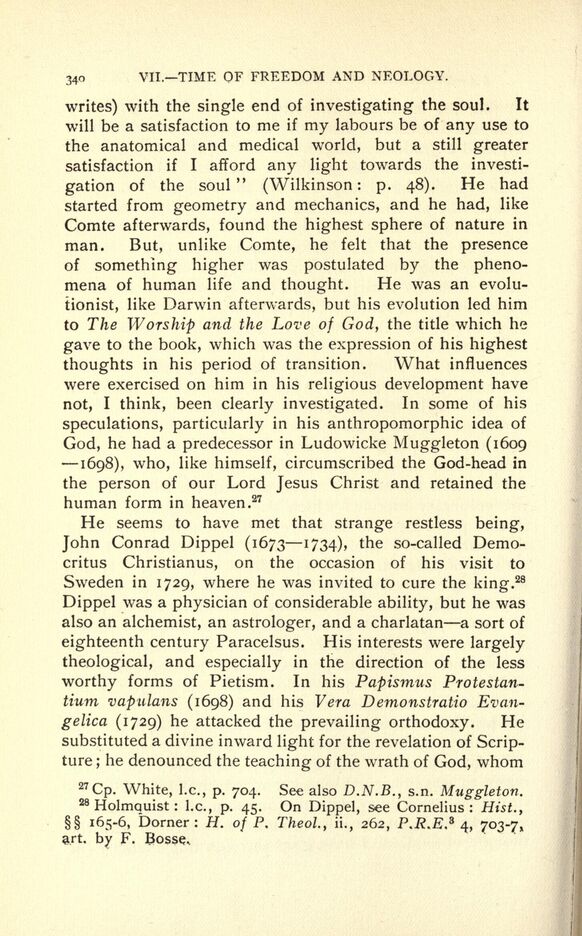
Full resolution (JPEG) - On this page / på denna sida - VII. The Church in the “Time of Freedom” and Period of Neology (1718—1811 A.D.)

<< prev. page << föreg. sida << >> nästa sida >> next page >>
Below is the raw OCR text
from the above scanned image.
Do you see an error? Proofread the page now!
Här nedan syns maskintolkade texten från faksimilbilden ovan.
Ser du något fel? Korrekturläs sidan nu!
This page has never been proofread. / Denna sida har aldrig korrekturlästs.
34o VII. TIME OF FREEDOM AND NEOLOGY.
writes) with the single end of investigating the soul. It
will be a satisfaction to me if
my labours be of any use to
the anatomical and medical world, but a still greater
satisfaction if I afford any light towards the investi
gation of the soul" (Wilkinson: p. 48). He had
started from geometry and mechanics, and he had, like
Comte afterwards, found the highest sphere of nature in
man. But, unlike Comte, he felt that the presence
of something higher was postulated by the pheno
mena of human life and thought. He was an evolu
tionist, like Darwin afterwards, but his evolution led him
to The Worship and the Love of God, the title which he
gave to the book, which was the expression of his highest
thoughts in his period of transition. What influences
were exercised on him in his religious development have
not, I think, been clearly investigated. In some of his
speculations, particularly in his anthropomorphic idea of
God, he had a predecessor in Ludowicke Muggleton (1609
1698), who, like himself, circumscribed the God-head in
the person of our Lord Jesus Christ and retained the
human form in heaven.27
He seems to have met that strange restless being,
John Conrad Dippel (1673 1734), the so-called Demo-
critus Christianus, on the occasion of his visit to
Sweden in 1729, where he was invited to cure the king.
28
Dippel was a physician of considerable ability, but he was
also an alchemist, an astrologer, and a charlatan a sort of
eighteenth century Paracelsus. His interests were largely
theological, and especially in the direction of the less
worthy forms of Pietism. In his Papismus Protestan-
tium vapulans (1698) and his Vera Demonstratio Evan-
gelica (1729) he attacked the prevailing orthodoxy. He
substituted a divine inward light for the revelation of Scrip
ture ;
he denounced the teaching of the wrath of God, whom
27
Cp. White, I.e., p. 704. See also D.N.B., s.n. Muggleton.
28
Holmquist :
I.e., p. 45. On Dippel, see Cornelius: Hist.,
165-6, Dorner : H. of P. TheoL, ii., 262, P.R.E* 4, 703-7,
art. by F. Bosse^
<< prev. page << föreg. sida << >> nästa sida >> next page >>